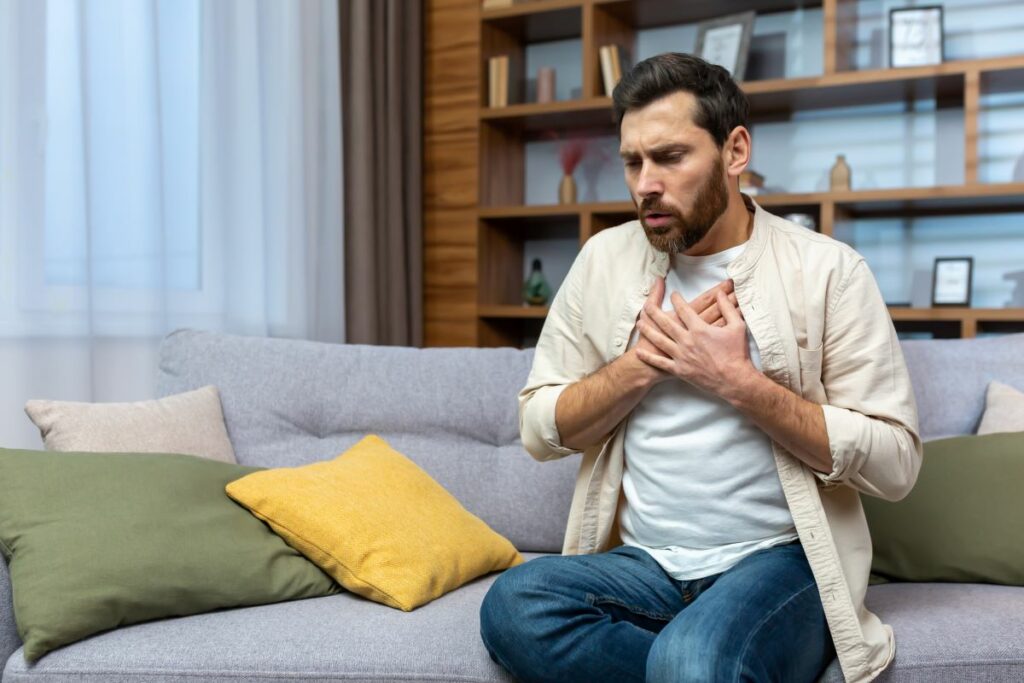Anxiety paralysis refers to the intense feeling of being emotionally or physically immobilized due to overwhelming anxiety or stress.
This condition manifests when the autonomic nervous system’s freeze response is activated, often during periods of acute anxiety.
The experience can range from a temporary inability to move or speak to a complete emotional shutdown, where a person feels incapable of processing their surroundings or responding to them.
Understanding Anxiety Paralysis

Anxiety paralysis occurs when an individual experiences overwhelming anxiety that impedes their ability to move or act.
Rooted in the body’s stress response, this phenomenon can manifest as a freeze response, an evolutionary adaptation humans share with other animals.
The autonomic nervous system (ANS), responsible for regulating involuntary bodily functions, includes the sympathetic and parasympathetic nervous systems.
During a perceived threat, the sympathetic nervous system activates the fight, flight, or freeze response, preparing the body to confront or escape danger. The freeze response is a form of submission or a last-ditch effort to avoid a predator when fight or flight is not an option.
The Role of the Amygdala
At the heart of the ANS’s response is the amygdala, an almond-shaped brain structure that processes emotions.
When overly activated by stress or threat, the amygdala can cause the body to shut down movement, leading to what is termed anxiety paralysis. It’s as if the body is conserving energy or playing dead in the face of inescapable stress.
Anxiety paralysis is not just a full-body freeze; it can also refer to a mental state of indecision or the inability to perform routine tasks.
Physical Anxiety Paralysis
Physical anxiety paralysis involves a sensation of being unable to move or take action due to intense feelings of anxiety or fear. It may manifest as:
| Indicator | Description |
|---|---|
| Muscle Tension | Anxiety can cause muscle tension throughout the body, leading to stiffness or rigidity that makes movement difficult. |
| Freezing | In response to perceived threats or stressors, the body’s natural “fight, flight, or freeze” response may activate, causing individuals to freeze in place rather than take action. |
| Hyperventilation | Rapid or shallow breathing, known as hyperventilation, is a common symptom of anxiety that can lead to dizziness, lightheadedness, and a feeling of being unable to move. |
| Panic Attacks | Severe anxiety may trigger panic attacks, characterized by intense physical symptoms such as chest pain, shortness of breath, and trembling, which can immobilize individuals temporarily. |
Physical anxiety paralysis can interfere with everyday tasks such as driving, speaking in public, or even getting out of bed, significantly impacting an individual’s quality of life and functioning.
Emotional Anxiety Paralysis

Emotional anxiety paralysis refers to a state of psychological immobilization or feeling “frozen” emotionally due to overwhelming anxiety or stress. It may involve:
| Indicator | Description |
|---|---|
| Emotional Numbness | In response to intense anxiety or trauma, individuals may experience emotional numbness or detachment, making it difficult to connect with or express their feelings. |
| Avoidance Behaviors | Fear of experiencing anxiety-provoking situations or emotions may lead individuals to avoid certain activities, relationships, or responsibilities, contributing to a sense of emotional paralysis. |
| Rumination | Excessive worry or rumination about past or future events can trap individuals in a cycle of negative thoughts and emotions, preventing them from taking action or moving forward. |
| Decision Paralysis | Anxiety can interfere with decision-making processes, causing individuals to feel overwhelmed by choices or afraid of making the wrong decision, leading to indecision and inaction. |
Emotional anxiety paralysis can impact relationships, career opportunities, and personal growth, as individuals may struggle to engage fully in life due to fear and uncertainty.
Causes and Triggers
Understanding the causes and triggers of anxiety paralysis is central to recognizing and addressing this condition.
It involves various factors, from one’s genetic makeup to everyday environmental stresses.
Genetic and Biological Factors
Anxiety paralysis is sometimes rooted in genetic and biological factors, where an individual’s nervous system and brain chemistry play a role.
Research highlights that certain genes can increase vulnerability to anxiety disorders, making some individuals more susceptible to the symptoms of anxiety paralysis.
Environmental and Social Factors
Environmental and social factors often act as triggers for anxiety paralysis. Stressful life events or ongoing stressors, such as difficulties at school, work, or in personal relationships, can all contribute.
Social anxiety, resulting from fear of judgment or rejection in social settings, can also be a powerful trigger.
Health-Related Factors
Various health conditions can exacerbate or trigger anxiety paralysis. These include hormonal imbalances, depression, and side effects from certain medications.
In some cases, health-related triggers are closely linked to anxiety disorder itself, forming a complex interplay that impacts an individual’s ability to manage everyday tasks.
Diagnosis and Treatment Options

Effective management of anxiety paralysis involves a combination of professional diagnosis and a tailored treatment plan.
Selecting the right mix of medications, therapy, and coping mechanisms requires a detailed understanding of the individual’s specific symptoms and overall health.
Professional Diagnosis
A mental health professional can correctly diagnose anxiety disorders, differentiating them from other psychological issues.
Diagnosis typically involves a careful review of medical history, discussion of symptoms, and psychological evaluation.
It’s crucial to identify the type and severity of anxiety to inform the treatment plan.
Medications
For anxiety paralysis, medications can be a pivotal part of treatment.
Antidepressants, like SSRIs and SNRIs, are commonly prescribed for managing anxiety symptoms by balancing stress hormones like cortisol.
In acute cases, benzodiazepines may be used short-term to relieve intense anxiety, though they are generally avoided for long-term use due to potential dependency issues.
Therapy and Counseling
Cognitive-behavioral therapy (CBT) is a highly effective form of talk therapy for treating anxiety disorders.
CBT helps patients understand and change thought patterns that contribute to anxiety, equipping them with strategies to manage symptoms.
A licensed therapist may also employ other therapy forms based on the needs of the patient.
Coping Mechanisms and Strategies

In conjunction with medication and therapy, learning coping mechanisms and strategies is key for individuals managing anxiety paralysis.
Techniques include grounding exercises, breathing routines, and lifestyle changes that reduce anxiety triggers.
| Techniques | Description |
|---|---|
| Deep Breathing and Relaxation | Practice deep breathing exercises, progressive muscle relaxation, or guided imagery to calm the body’s stress response and reduce muscle tension associated with anxiety. Incorporate mindfulness meditation or yoga into your daily routine to promote relaxation and increase self-awareness. |
| Grounding | Use grounding techniques, such as focusing on sensory experiences (e.g., touching a textured object, listening to soothing music, smelling a calming scent) to bring your attention back to the present moment and alleviate feelings of dissociation or detachment. |
| Structured Routine | Establish a structured daily routine with regular sleep-wake cycles, meal times, and activities to promote stability and predictability in your daily life. |
These strategies help to modulate the body’s response to stress and build resilience against anxiety episodes.
Developing an effective approach to treat anxiety paralysis often requires adjustments and ongoing communication with a mental health professional to ensure the treatment plan remains suitable and effective.
Therapists Specializing in Anxiety
Frequently Asked Questions
What are the common treatments for anxiety-induced paralysis?
Treatments often include therapy, such as cognitive-behavioral therapy (CBT), and, in some cases, medication prescribed by healthcare professionals.
Strategies to reduce stress and manage anxiety symptoms are also recommended.
How can someone break free from the feeling of being emotionally paralyzed by stress?
To counteract emotional paralysis, individuals may engage in relaxation techniques, like deep-breathing exercises, or seek support from therapists who can offer tailored strategies for managing stress.
What are the physical and mental symptoms associated with mental paralysis?
Symptoms of mental paralysis include an inability to move or speak, overwhelming feelings of fear, heavy limbs, and difficulty processing thoughts or surroundings.
These can be indicators of intense stress or anxiety.
How can the 3-3-3 rule be utilized to manage symptoms of anxiety?
The 3-3-3 rule assists in grounding individuals by having them name three objects they see three sounds they hear, and move three parts of their body when experiencing anxiety, bringing their attention back to the present.
What are effective methods for overcoming task paralysis due to anxiety?
Overcoming task paralysis can be achieved by breaking tasks into smaller, manageable steps, prioritizing, and using positive self-talk to combat overwhelming feelings.
Consistent practice of these methods may improve one’s ability to take action.
References
Schmidt, N. B., Richey, J. A., Zvolensky, M. J., & Maner, J. K. (2008). Exploring human freeze responses to a threat stressor. Journal of behavior therapy and experimental psychiatry, 39(3), 292-304. Link.









